
FIFA Online Gameplay Responsiveness
Apr 2021
The Pitch Notes

Apr 05, 2021
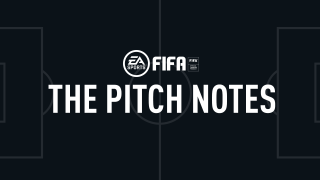
Hello all.
My name is Joel Doonan, and I am the lead Producer for the Player First Operations team, part of the FIFA Live team.
In this Pitch Notes, I am going to cover the latest updates on the ongoing online gameplay responsiveness efforts being undertaken by the FIFA Development Team.
Our last update, back in November, announced the addition of a new FIFA Game Data Center (FGDC) in Miami, as well as the introduction of two new tools, in-game Connection Monitoring options and the EA Connection Quality Report website.
In the months since that update, online gameplay responsiveness continues to be a top priority for us, with our focus in two primary areas, internal infrastructure and external education, information, and tools. In this update, I am going to touch on a few different topics:
Infrastructure:
- New FGDC in Buenos Aires, Argentina
- Impact of FGDC in Miami
Information, Education and Tools:
- Input Overlay
- Report Match For Connection Quality
Let’s jump in.
TL;DR
- New FIFA Game Data Center (FGDC) is now live in Buenos Aires, Argentina.
- For a full list of all current FGDCs, see here.
- Input Overlay is now available for use in-game.
- For more details, see here.
- Report Match For Connection Quality is now available for use in-game.
- For more details, see here.
- The addition of the Miami FGDC has had a positive impact on connection quality metrics for the player communities in Florida, the Carribean, Central America and some parts of South America.
New FGDC in Buenos Aires, Argentina
Today we are announcing that we are officially live with a new FGDC in Buenos Aires, Argentina. With this addition, the recent addition of the Miami FGDC, and the existing FGDC in São Paulo, we have significantly expanded the FGDC coverage for our players in South America.
We expect that this new FGDC will provide improvements to the player experience in southern South America, but we will continue to monitor and look for options to improve the experience for all our players where we can. We will also look to detail the impact of this new FGDC in a future Pitch Notes.
Input Overlay
Included as part of the recent FIFA 21 Title Update 11.1, we are happy to announce that the Input Overlay option is available for all players to use in-game.
Input Overlay is a setting that displays controller graphics on screen while you play, letting you watch the inputs you perform during a match. These visuals can be used as a tool to help you monitor your in-game actions, send us detailed gameplay responsiveness feedback on Answers HQ, and even to see how your inputs are processed by FIFA Game Data Centers and your network during online play.
To see how to enable this setting, and what the various options do, check out this article. With this enabled, and depending on the settings you choose, you will be able to see things like:
- What button presses were registered on the controller.
- The time it takes for the information that you pushed a button to make the trip to the FGDC and back, which is the actual time it will take for the action you requested by pushing that button to take place.
Here is an example of how it looks in-game, with the Local Input + Online Response option enabled.
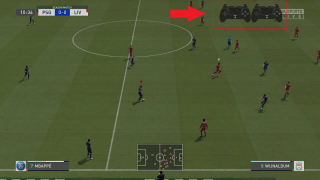
If you are ever sharing videos of online gameplay responsiveness issues, whether that is through social media, via Answers HQ, or really anywhere, having the Local Input + Online Response option enabled will make it much more likely that we can learn something from your video.
For the past year, we have been using a test version of the input overlay as part of the online gameplay responsiveness investigations, as detailed in a previous Pitch Notes. It was enabled for a small group of players to assist with those investigations, and it was so helpful when the FIFA Development Team was reviewing videos from players of responsiveness issues that we wanted to make it available for all players.
We are really happy that this tool is available for all our players to use and we are confident that it will enable more effective investigations into player reported responsiveness issues.
Report Match For Connection Quality
Recently enabled for all players is the option to report a match that you are playing to the FIFA Development Team for connection quality issues. We detailed connection quality, what it is, and how it can impact your gameplay experience in this article, but to summarize, connection quality is about the speed, reliability and consistency of your connection, and how that can impact your gameplay experience.
This option, available in the Pause Menu and Post Match screens for most game modes, sends the FIFA Development Team connection quality information about the match that you are currently playing. This allows us to collect data from the whole FIFA community about matches that our players believed were impacted by connection quality issues to help further our investigations.
The below view of the Pause Menu highlights where you can see the option on the screen.
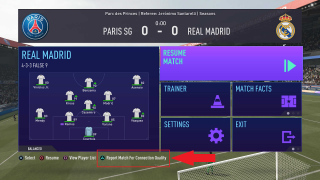
For more details on how to use this, and when it’s most appropriate to use, please check out this article.
Impact Of Miami FGDC
When we announced the addition of a FGDC in Miami, we said that while we expected that it would bring some connection quality improvements to players in the southeastern United States, that the primary intention of the site was to actually help players in Central America, the Caribbean, and northern part of South America due to the internet routing that takes place in those regions.
With the FGDC live in Miami for a number of months now, we wanted to share insight into some of the improvements we, and our players in these communities, have seen.
First off, let’s start with the most obvious, the impact that it has had in the state of Florida. In a previous Pitch Notes, we talked about how one of the ways that we identify and evaluate new FGDC locations is by how they are going to improve the ping for players in that region. I detailed in that article how we are working towards an internal target of having as many FGDC FIFA Online Matches as possible being played with an average of 50ms of ping or less. While we have gathered feedback from players that games at a higher ping value can be responsive, we want to push an aggressive target, given our worldwide player population, as part of our efforts around Online Gameplay Responsiveness.
With the above in mind, the below shows the percentage of matches being played in Florida, under that 50ms target, before and after the new FGDC was added in Miami, with approximately 15% more of the total matches being played in the state of Florida now being played under that 50ms threshold.
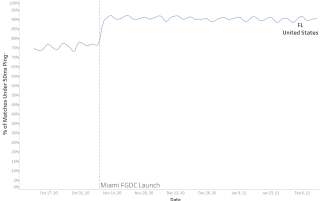
When looking at the United States as a whole, we didn’t see much of a change to the overall percentage of matches within the country being played below that 50ms threshold, which sits between ~80-90% currently. This was expected given that the United States has multiple FGDCs located throughout the country, so the benefit of the Miami FGDC to players in the United States was largely localized to Florida.
Now let’s take a look at how this FGDC has impacted Central America, the Caribbean and the northern parts of South America.
First, to help showcase how internet routing often doesn’t align with geography, let’s take a look at a heatmap of the surrounding regions, showing the percentage of matches, per location, that were being played on the Miami FGDC after it went live.
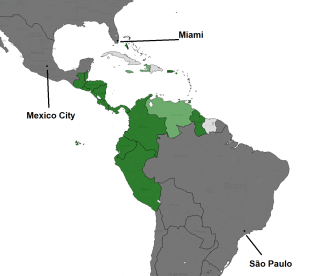

Despite the physical distance in some cases, especially over land, the majority of matches in Central America, the Carribean and northern South America are now being played on the Miami FGDC. As mentioned, internet routing, the way internet cabling may be laid, including underwater, and other infrastructure causes could be the reason for this.
Given how matchmaking in FIFA 21 works, this generally indicates that this location is giving those players an improved connection quality than they would have on the sometimes physically closer Mexico or Brazil FGDCs.
Now let’s look specifically into Central America and the Carribean. The below shows the percentage of matches being played under that 50ms target in a few Central American and Carribean locations, before and after the new FGDC was added in Miami. The percentage jumps are, in many cases, quite significant and generally result in the majority of the matches in these locations now being played below that 50ms target. We are really pleased and excited to see this level of improvement to the connection quality of our players in these locations.
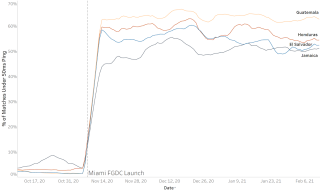
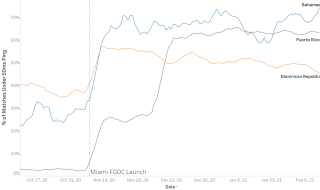
Pivoting our view over to South America, specifically those locations from the map that show a high percentage of matches being played in Miami. While we did see improvements to the ping that many of the matches from those locations were being played on, the percentage of matches being played under 50ms didn’t increase as significantly as it did for the majority of Central America and the Carribean. That being said, ping is only one factor that goes into the connection quality of a match, so let’s instead look at a relatively new metric for us, Connection Score.
Connection Score is a connection quality measurement that we use on the EA Connection Quality Report (CQR) website, which was released as a beta back in November 2020, to help educate players and to provide them with data about their connection quality. To explain what the Connection Score is, here is an excerpt from the CQR FAQ:
What is the Connection Score?
The Connection Score is a value ranging from 0-100 that consists of a summary of three key Connection Quality metrics: ping, packet loss, and jitter.
It is intended to provide a general sense of the quality and stability of the associated connection.
So when looking at the Connection Score, we are taking more than just ping into consideration, giving us a broader look at the connection quality of a match.
The formula used to generate the Connection Score can scale, being used to score a specific match, or to provide the average, based on FIFA online matches, for a player or location in the world.
So for this next graph below, let’s look at how the average FIFA online match Connection Score in those northern South America locations was impacted by the addition of the Miami FGDC.
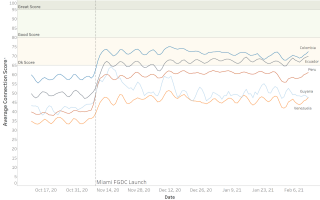
With the exception of Guyana, which has fluctuated a fair bit, the other locations have seen a 10-20 point Connection Score increase since the addition of the Miami FGDC, which is a really positive improvement.
However, even with these increases, the Connection Score values are still sitting below where we would like them to be. So while we are encouraged to see that the Miami FGDC has made some improvements in northern South America, we continue to look for opportunities in this region to further improve the experience for all our players.
___
Summary
We hope that this deep dive has been informative. We think it’s important to show you the progress that is being made in the online gameplay responsiveness space, and to know that it continues to be a top priority for our team.
I would highly encourage everyone to check out the EA Connection Quality Report. If you are experiencing any connection quality issues when playing FIFA 21, it is intended to help you gain a better understanding of why that may be happening and to give you some guidance on what you may be able to do to improve it.
With in-game Connection Monitoring options, the input overlay and the ability to report a match for connection quality issues, players now have tools available within the game to help better understand their connection quality, as well as to help directly inform the ongoing investigations by the FIFA Development Team.
As always, thank you for reading, thank you for your constant and continued passion and support for this game and thank you for your feedback.
Make sure you check out the EA SPORTS FIFA Tracker and follow @EAFIFADirect on Twitter for the latest information from the Development team.
Joel Doonan and the FIFA Development Team
--
For more deep dives on FIFA from members of the game team, check out the Pitch Notes Page.
Please Note: This article is describing in general terms what the Dev Teams are working on. We are constantly looking to improve the FIFA experience for everyone, so this article may become outdated as we make adjustments to keep our game fun for everyone.
Stay in the conversation on all things FIFA by liking us on Facebook, following us on our official Twitter and Instagram, our Dev twitter channel @EAFIFADirect, on the EA SPORTS FIFA Tracker and participating in the official FIFA Forums. Sign-up to receive emails about EA SPORTS FIFA and EA products, news, events, and promotions.

